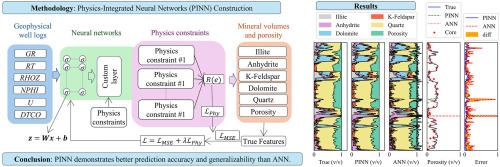Physics-integrated neural networks for improved mineral volumes and porosity estimation from geophysical well logs
IF 3.6
引用次数: 0
Abstract
Accurate estimation of mineralogy from geophysical well logs is crucial for characterizing geological formations, particularly in hydrocarbon exploration, CO2 sequestration, and geothermal energy development. Current techniques, such as multimineral petrophysical analysis, offer details into mineralogical distribution. However, it is inherently time-intensive and demands substantial geological expertise for accurate model evaluation. Furthermore, traditional machine learning techniques often struggle to predict mineralogy accurately and sometimes produce estimations that violate fundamental physical principles. To address this, we present a new approach using Physics-Integrated Neural Networks (PINNs), that combines data-driven learning with domain-specific physical constraints, embedding petrophysical relationships directly into the neural network architecture. This approach enforces that predictions adhere to physical laws. The methodology is applied to the Broom Creek Deep Saline aquifer, a CO2 sequestration site in the Williston Basin, to predict the volumes of key mineral constituents—quartz, dolomite, feldspar, anhydrite, illite—along with porosity. Compared to traditional artificial neural networks (ANN), the PINN approach demonstrates higher accuracy and better generalizability, significantly enhancing predictive performance on unseen well datasets. The average mean error across the three blind wells is 0.123 for ANN and 0.042 for PINN, highlighting the superior accuracy of the PINN approach. This method reduces uncertainties in reservoir characterization by improving the reliability of mineralogy and porosity predictions, providing a more robust tool for decision-making in various subsurface geoscience applications.

物理集成神经网络,用于改善地球物理测井中矿物体积和孔隙度的估计
从地球物理测井资料中准确估计矿物学对地质构造的特征至关重要,特别是在油气勘探、二氧化碳封存和地热能开发中。目前的技术,如多矿物岩石物理分析,提供了矿物学分布的细节。然而,它本质上是耗时的,并且需要大量的地质专业知识来进行准确的模型评估。此外,传统的机器学习技术往往难以准确预测矿物学,有时会产生违反基本物理原理的估计。为了解决这个问题,我们提出了一种使用物理集成神经网络(pinn)的新方法,该方法将数据驱动学习与特定领域的物理约束相结合,将岩石物理关系直接嵌入到神经网络架构中。这种方法强制预测遵循物理定律。该方法被应用于Broom Creek Deep Saline含水层(Williston盆地的一个二氧化碳封存点),以预测关键矿物成分(石英、白云石、长石、硬石膏、伊利石)的体积以及孔隙度。与传统的人工神经网络(ANN)相比,PINN方法具有更高的准确性和更好的泛化性,显著提高了对未知井数据集的预测性能。三口盲井的平均误差ANN为0.123,PINN为0.042,突出了PINN方法的优越精度。该方法通过提高矿物学和孔隙度预测的可靠性,减少了储层表征的不确定性,为各种地下地球科学应用提供了更强大的决策工具。
本文章由计算机程序翻译,如有差异,请以英文原文为准。
求助全文
约1分钟内获得全文
求助全文

 求助内容:
求助内容: 应助结果提醒方式:
应助结果提醒方式:


